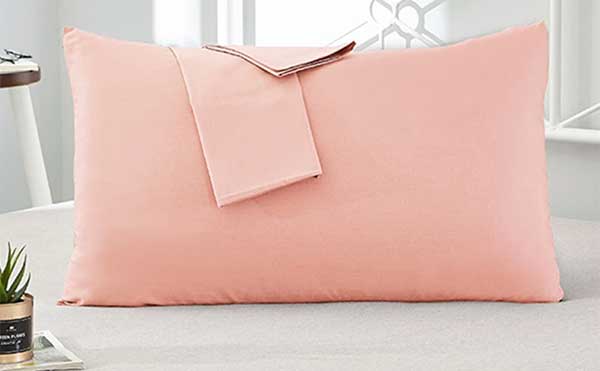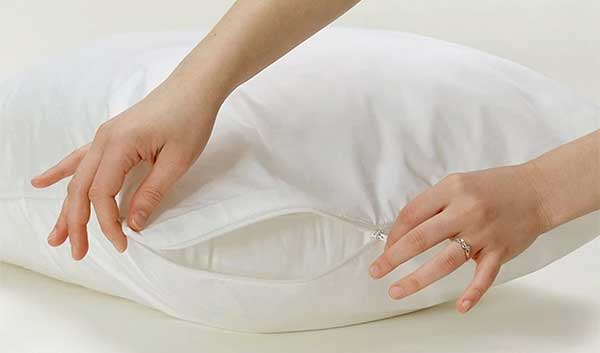So you may have just come across this thing called a pillow protector, or maybe you already own a few. But now for the confusing part, why is there a pillow protector and a pillowcase? Aren’t they the same? How are they different and should we use both of them?
Long story short, pillow protectors are more for “protective purposes”, while pillowcases are more for “cosmetic purposes”. That answers the question in a quick way, but let us walk through more in this guide. Read on!
WHAT IS A PILLOWCASE?

Captain Obvious at your service, you should already know this one and own a number of pillowcases. Pillowcases are simply removable pillow covers, put in another way, “just pieces of cloth”. They can be made from a thin piece of fabric that is purely for ornamental purposes and provides little protection for the pillow.
WHAT IS A PILLOW PROTECTOR?

On the other hand, a pillow protector is “a different type of removable pillow cover”. As the name suggests, the main purpose of a pillow protector is to protect the pillow (not so much as a “pillow cosmetic”). The common traits of a pillow protector are:
- Waterproof, hypoallergenic, anti-bacterial, anti-dust mites.
- Usually thicker to provide more “padding and protection”.
- Commonly comes with zippers. They fully enclose the pillow to shield it from “external elements” such as droll, sweat, oil, fluids, dust, dirt, dead skin, etc…
WHAT IS A PILLOW PROTECTOR USED FOR?
Well, a pillow protector is not just a “thin piece of cloth that does nothing but look good”. Most of you guys should have already guessed these, but being “encased in protection” helps to keep the pillow a lot cleaner and therefore lasts longer.
- Waterproof – Prevents the pillow from absorbing sweat, oil, saliva… Maybe even soda for the people who drink on the bed. This will stop funky pillow stains in the long run.
- Anti-dust mites – People do shed dead skin and dandruff while sleeping. A pillow protector will prevent these “micro bits” from building up on the pillow and stops it from becoming a paradise for bacteria/dust mites.
- Hypoallergenic – That is, “friendly for people who are sensitive”. It’s great to not wake up while sneezing, coughing, and teary-eyed.
- Protection – In the case of unfortunate spills and… pukes, there is thankfully a pillow protector. Just replace the protector, and you get to keep the pillow.
- Cost Saving – Reduces wear and tear on the pillow itself, extends the life of the pillow.
Condensed summary – A pillow protector is used to help to keep the pillow clean, reduce wear and tear so that it lasts longer. The human will also be happier and healthier with better nights of sleep.
THE NOT-SO-GOOD THINGS ABOUT PILLOW PROTECTORS
But of course, having a pillow protector does not turn the pillow “indestructible”. There are some people in this world who still has reservations about using one.
- Thick – If you have a cooling pillow, the thicker pillow protectors may not be the best idea. It hinders the cooling instead.
- Waterproof – There’s one school of people who says waterproof is good, and another that says “fabrics need to breathe”. Yes, there are arguments that say waterproofing is counter-intuitive. Isn’t it disgusting when sweat accumulates on the surface? Isn’t it better if the fabric absorbs it, but dries up fast?
- Common Sense – If you are one to replace pillows every year, using a pillow protector does not add much anyway; It becomes a hassle to clean them instead.
NOT ALL PILLOW PROTECTORS ARE THE SAME
To follow up with the above not-so-good things about pillow protectors, not all pillow protectors are the same. Just like pillowcases, there is a whole range of pillow protectors to choose from, to address the needs of various people:
- Too thick? Then look for the thinner protectors that are literally “waterproof sheets”. Although the lack of padding will not provide much wear-and-tear protection.
- For the folks who are afraid that waterproof is going to form a puddle of sweat, get a breathable protector then. Although the moisture will eventually stain the protector, maybe even seep into the pillow.
- Have a pillow that is slightly too flat? Get a pillow protector that has some “heavy padding”, that will help to “puff it up”.
The key point here is, that there are pros and cons to each type and design of pillow protector. Having a pillow protector is still better than none.
MUST WE USE A PILLOW PROTECTOR & PILLOWCASE?
Do a quick search on the Internet, and you will find many people recommending the same thing. Use the pillow protector as the “inside layer”, and the pillowcase as the “outside layer”. Wash the pillowcase every week, and the protector every month. It’s not that much of a hassle anyway, just throw them into the washing machine along with your usual laundry.
But well, there are no laws that say “it is illegal to use pillows without a pillow protector”. Nobody is stopping you from sleeping on a “naked pillow” without a pillow protector and pillowcase. The only questions are – Does it make sense? Is it better?
Personally, the benefits outweigh the small hassle of washing the protector. Pillow protectors keep the pillow clean, it’s more hygienic, and it extends the life of the pillow. So… It there a reason to not use pillow protectors?
THE END

Thank you for reading, and we have come to the end of this short guide. For you guys who are still thinking “a single layer of the pillowcase is enough”, well, not quite. A pillow protector is simply superior in terms of protection. Don’t be lazy and get one now. I hope it has helped to answer your doubts. Good luck and have better nights of sleep!
LINKS & REFERENCES
- Is It OK To Sleep Without A Pillowcase – The Daily Bed
- Why You Need a Pillow Protector – Down ETC

